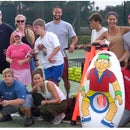Introduction: Adaptive Paddle
The current design for enabling people to paddle outriggers with the use of one arm had a little draw back in that the paddle kept rotating. Without a second hand on top of the paddle there was no way the paddle could control the angle at which the blade dug in to the watter.
Funny little aside, at the time talking about the problem I shot an idea out that instead of hanging the paddle from a flexible pole by a bungee, fix it via a bolt to the pole. I forgot all about that and then over the winter set about with the design describe below. All happy with the prototype I proudly presented to the team at the first camp this year only to find they'd implemented the bolt-pole idea and it works a treat. That said, we're going to continue developing the adaptive handle as its already built.
Step 1: Rough Template
In the sketch below you can see the two basic components of the prototype. Firstly the user places their forearm in the horizontal section and secures with neoprene bands. The paddle is attached to the prototype above and below the hand.
Step 2: Glass It
1) I cut a large Y shape out of some divinycell 40 foam board.
2) Heated the forearm section and bent it to form a half pipe
3) Cut Y shape of 9 oz s-glass larger than the foam, it will wrap around the foam by about an inch
4) I mixed some epoxy resin and wet the foam core to ensure a good bond
5)lay down the glass and wet it epoxy completely
6) then lay down the release fabric which allows you to pull off the breather fabric.
7) The release fabric (darcon) is then stitched together on the reverse side to pull it and the glass underneath tort.
8) Then lay down the breather fabric which soaks up excess resin squeezed out by the vacuum press
Step 3: Bag It
The purpose of the vacuum press is to apply and even pressure to all surfaces. I set the contraption to draw around 20Hg. Depending on ambient temperature the resin will cure in anythign from 4 to 10 hours.
Once cured I cut the tread and peel back the release fabric which takes the breather fabric containing the excess resin off too.
Step 4: Cover in Neoprene
To help avoid any wear on the athlete's skin I decided to cover the adapter in neoprene. Simply cut out a shape that will wrap around the adapter and contact cement it together. I then glued the seam/join with a specific neoprene adhesive, you could easily just stitch it together
Step 5: Finished Design
I made clips for the paddle shaft with an aluminium rod (approx 1.5cm x 2mm) and stainless bolts with wingnuts to allow people to change paddly in the field or account for tapered shafts.
This was designed for Josh who is right handed with the idea being you flipped it over and attached the paddle accordingly... but it seems to work just as well for both right hand and left without having to reseat the paddle.
So, this is designed to work with the fibre glass rod and bungee cord as seen in the very first photo. The advantage of thie desing over both the original and the first revision is that this allows the athlete to lift the paddle out of the water away from the hull (fault of the second design is that its like a catipllar track in motion) yet this maintains the blade at 90 to the direction of travel,













